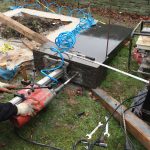
Anchoring the stone preparation
The British Standard 8415 (BS8415) sets out the minimum lengths of anchoring that are needed ensure memorial safety so that there is no danger of them toppling over. Although not legally binding, the BS8415 is adopted by all members of the British Association of Memorial Masons (BRAMM) and National Association of Memorial Masons (NAMM).
The death of a child as a result of a falling headstone in a cemetery in Harrogate in 2000 led to many headstones being laid flat for health and safety reasons. It was clear that the memorial industry needed to regulate itself for public reassurance and this led to the introduction of the BS8415 in 2005.
The Ministry of Justice’s guidance document for managing the safety of burial ground memorials includes reference to BS8415, encouraging masons to make headstones to that standard. They specify minimum lenghs of anchoring, subject to ground conditions. The anchoring system does not require concrete adhesives meaning that memorials can easily be removed if necessary for maintenance or if somebody else is being interred in the grave.
BRAMM offers a fixers licence, renewable every five years, that requires a practical and written test, meaning that masons can demonstrate that they have the ability to carry out work to the standards required. Members of NAMM agree to install memorials in line with their Code of Working Practice. This means that the memorial industry is now self regulating and since the introduction of BS8415 there have been no serious injuries as a result of falling headstones.
Many Local Councils do not allow any masons to work in their cemeteries unless they adhere to the NAMM standards. As such you can be rest assured any work carried out by Halton Memorials, who are a member of BRAMM, will be done to the highest standards.